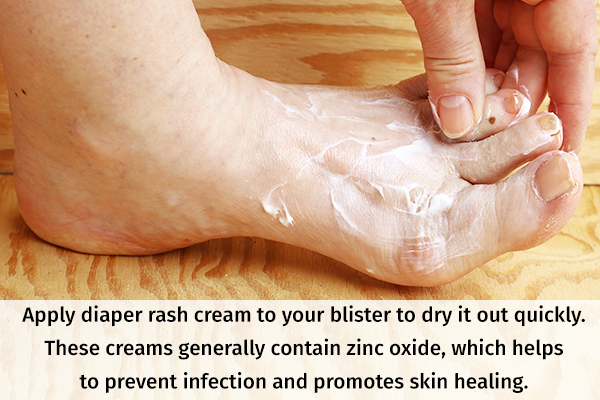In this article:
A foot blister or vesicle is a fluid-filled sac that forms under the skin of the foot when it is subjected to excessive pressure or friction. (1) The fluid buildup causes redness, swelling, and pain in the affected area and makes the lesion pop out of the surface.

These vesicles are usually small with a diameter of less than 1 mm, but they can be larger. The smaller ones are known as vesicles, whereas the larger ones are referred to as bulla. This article will discuss how you can treat these blisters at home and keep them from forming in the first place.
First-Line Treatment for Foot Blisters

This is the standard way to treat a foot blister, preferably within the first 24 hours of its formation:
- Use Betadine (povidone-iodine) antiseptic to clean the lesion.
- Apply antibiotic ointment over the blister.
- Cover the blister with a clean nonadhesive bandage after a few days.
- Make sure to change the bandage every day or when it becomes dirty or damp to prevent the wound from getting infected.
Dos and Don’ts for Proper Wound Healing

Here are a few tips that can make your foot blister hurt less and heal faster:
1. Apply a wet washcloth on your blister
Apply a wet washcloth on your blister to relieve the pain and itching. Simply soak the cloth in cold water, wring out the excess fluid, and then place it over the blister.
2. Apply diaper rash cream
Apply diaper rash cream to your blister to dry it out quickly. These creams generally contain zinc oxide, which helps to prevent infection and promotes skin healing.
3. Don’t pick the skin flap surrounding the blister
Don’t pick or pull away the flap of skin covering the blister, which acts as a shield against external irritants, dirt, and germs. All you need to do is gently pat the loose excess skin to smoothen it out.
If the loose skin starts accumulating dirt or pus, consult your doctor about getting the flap removed so that the wound can be properly cleaned.
4. Don’t use duct tape/adhesive bandages to cover blisters
Don’t use duct tape or adhesive bandages to cover the blister as they stick too strongly to the skin, and pulling them off can further irritate or damage the wound.
5. Avoid harsh skin irritants
Avoid irritants such as soaps and detergents, which contain harsh chemicals that can aggravate your blister-ridden skin. Instead, use mild, unscented cleansers to wash your feet until the blister heals.
Tips to Prevent Foot Blisters

Here are a few things you can do to avoid the formation of foot blisters:
1. Wear properly fitted footwear
Wear properly fitted footwear that doesn’t rub against your skin or squeeze your toes. If the fit is loose, the gap between the shoe and the foot will cause friction. If the fit is too tight, the edges of the shoe will tear your skin.
When you go shoe shopping, try out the pair in the store to make sure it fits snugly around your feet.
2. Keep your feet dry
Keep your feet dry at all times to prevent foot infections that can cause blister formation. Damp or sweaty feet enclosed within shoes are the perfect breeding grounds for infection-causing microbes that thrive in warm, humid, and closed environments.
So, it is very important to dry your feet before putting on socks or shoes. Plus, wear a fresh pair of socks daily, and change out of wet socks or shoes as soon as you can. If your feet are prone to sweating, you can sprinkle corn starch or talcum powder inside your shoes and socks to absorb the moisture.
3. Wear the right kind of socks
Wear the right kind of socks that wick moisture away from your feet rather than absorb it. Woolen or synthetic (acrylic) should be your top pick, (2) and avoid cotton ones that take forever to dry once they become damp.
Also, a thin inner liner (“wicking”) sock and a thicker outer sock can be worn together.
4. Use a piece of tape or Band-Aid
Stick a piece of tape or Band-Aid on the inner border of your footwear or your skin where it touches the footwear. This will act as a buffer between your foot and the shoe to minimize undue friction and provide thermal insulation from the heat generated from any friction.
This tip is especially useful when you are breaking in a new pair of shoes, sandals, or boots.
5. Apply powder or petroleum jelly
Apply powder or petroleum jelly on areas where the skin rubs against your footwear. This will allow the skin to glide against the border of the shoe during movement without much friction.
Is Apple Cider Vinegar a Good Home Remedy for Foot Blisters or Vesicles?

No, the acidic nature of apple cider vinegar (ACV) will further irritate your already sensitive skin and dissolve the thin outer layer of skin covering the blister.
Final Word
Foot blisters or vesicles are not a health emergency, but they can be quite discomforting and can significantly limit your mobility. Negligent care and hygiene can open up the wound to secondary infections, which may take longer to heal and can induce other complications in their wake.
Timely treatment will reduce your discomfort, keep infections at bay, and ensure a speedy recovery. In most cases, these lesions are easy to treat and do not pose a serious threat.
But if the preliminary treatment doesn’t work or if you notice signs of infection around the wound site, consult your doctor to receive the proper treatment. Sometimes, the blister can be an indication of a more serious underlying condition that warrants proper medical examination.

- Was this article helpful?
- YES, THANKS!NOT REALLY


